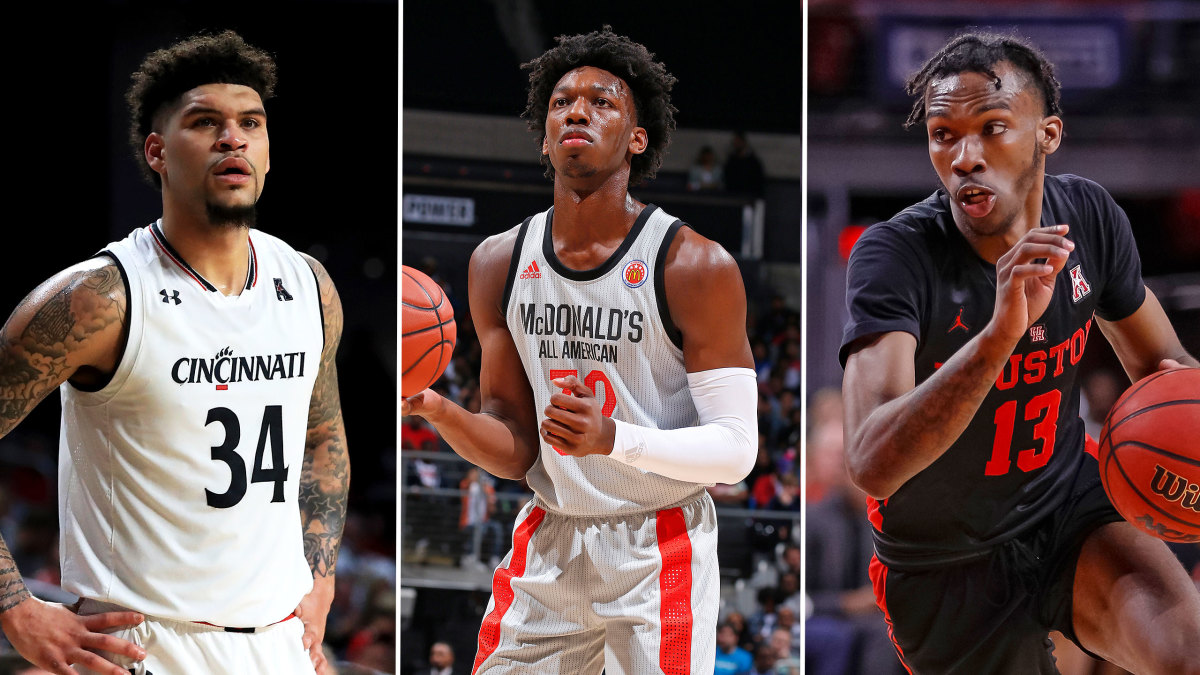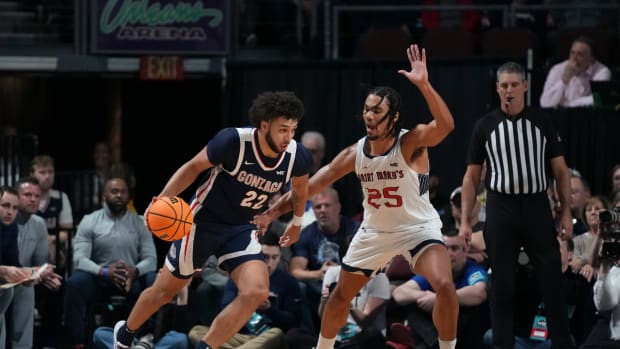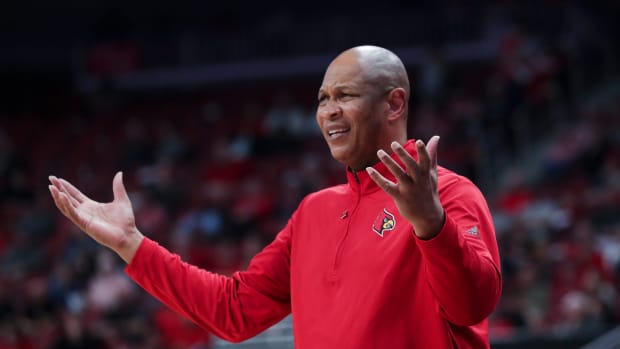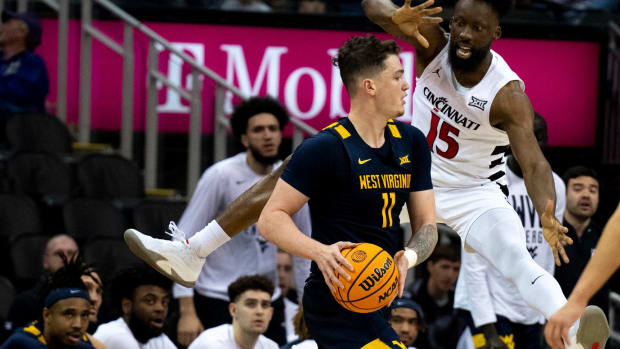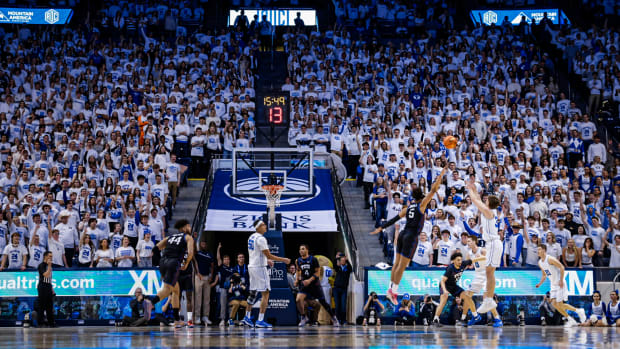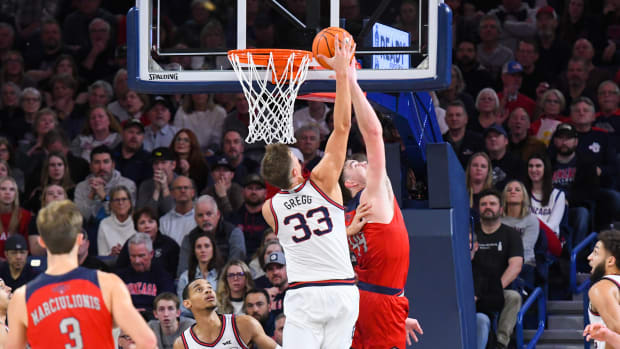AAC Basketball Preview: Will Memphis Live Up to the Hype in 2019-20?
As part of SI.com's preview of the 2019–20 college basketball season, we're breaking down each of the seven major conferences, plus the best of the rest. First up for our conference previews is the AAC, complete with our analyst's breakdowns of each team and a projected order of finish.
The Big Picture
The AAC fielded eight teams with overall records above .500 last season while just four of them—Houston, Cincinnati, Temple and UCF—found their way to college basketball’s brightest stage in March. With less than a handful of teams being awarded a spot in the NCAA tournament each year since the league’s inception in 2013, success in conference matchups is vital to a tournament résumé. Some established programs are looking to ride momentum from last season while others hope to regain national relevance with revamped rosters. A season of new freshmen, transfers and coaches awaits, making the AAC one of the more interesting under-the-radar conferences to watch this year.
Conference POY: Jarron Cumberland, Cincinnati
Cumberland doesn’t just stand out among the AAC. He’s proven himself to be one of the best guards in the country, especially after taking home last season’s conference hardware. When he announced his return for a senior season, he virtually scribbled his name on the short list for this season’s All-American First Team. Cumberland’s 18.8 points per game ranked third among AAC scorers and is likely to increase under new head coach John Brannen. The former Northern Kentucky coach had the Norse shooting at 78.5 points per game last season—eight more than the team averaged during his first year with the program in 2016–17. Cumberland’s ceiling—along with the Bearcats’—weighs heavily on the status of a recurring foot injury which limited him over the summer and the start of fall. If Cumberland’s injury doesn’t hamper him throughout the season, he’s definitely one to set the bar for the AAC.
Newcomer of the Year: James Wiseman, Memphis
There’s very little from stopping Wiseman, the country's top 2019 recruit, from completely overlooking something as minuscule as the AAC Freshman award and just moving straight into the conversation for the Naismith. If the national rankings are any indication of what’s to come, Wiseman’s play is going to catapult the Tigers up the conference standings. The 7’1” center pulled together a monstrous senior season at nearby Memphis East (Tenn.) High School, averaging 25.8 points, 14.8 rebounds and 5.5 blocks. No, seriously.
Darkhorse Team to Win the Conference: South Florida
Nobody will be surprised if Houston and Cincinnati make another run at the conference crown. And Memphis seems like an obvious choice to break through. Wichita State is a bold pick, but the Shockers have been there before. How about extra bold? USF is bringing back nearly all of its main contributors from last season including AAC Third-Team selections David Collins and Laquincy Rideau, but its most intriguing piece might be last year’s AAC Freshman award winner Alexis Yetna. The Bulls already put together 24 wins last season. If they find a much-needed offensive identity, maybe things get weird atop the conference.
First Team All-Conference
DeJon Jarreau, guard, Houston
Jarron Cumberland, guard, Cincinnati
Quinton Rose, guard, Temple
Precious Achiuwa, forward, Memphis
James Wiseman, center, Memphis
Sixth Man of the Year: James Bouknight, guard, UConn
Predicted Order of Finish
1. Memphis
Penny Hardaway’s impact on the Tigers is quickly coming to fruition. The second-year head coach propelled his alma mater to its best season in five years and now holds the No. 1 recruiting cycle of 2019 in his back pocket. His hometown recruiting pitches have clearly been persuasive as this year’s Memphis squad consists of eight athletes who played high school ball in the city. Now, preseason expectations are skyrocketing upon the arrivals of five-star gems James Wiseman and Precious Achiuwa along with five four-star players. Historically, freshmen-laden teams have struggled to reach the mountaintop. This Memphis squad could face similar problems with only three regular contributors from last season returning, including one senior (no juniors). Only three teams in history have predominantly started five freshmen, none of which have won it all (Michigan in 1991–92, Kentucky in 2013–14 and again in 2017–18). Can the Tennessee kids break the trend?
2. Houston
Kelvin Sampson’s latest group enjoyed the program’s best season since Clyde and Hakeem walked the hardwood. As a No. 3 seed in the NCAA tournament, the Cougars reached the Sweet 16 for the first time in 35 years. The losses of Corey Davis Jr., Armoni Brooks, and Galen Robinson Jr. will sting, but Sampson has done more with less in the past. Junior guard DeJon Jarreau could be in line for a breakout season after winning the conference’s Sixth Man award last season. A backcourt in need of replenishment also falls on the hands of sophomore guard Nate Hinton, who showed promising flashes in his first year on campus. The incoming transfer of former Kansas guard Quentin Grimes is an intriguing pickup, but the Cougars might have to wait another year to get him involved with his impending waiver yet to be granted by the NCAA.
3. Cincinnati
The Bearcats enter 2019–20 with the potential to make their 10th straight NCAA tournament appearance. While Cincinnati was bounced in the first round by No. 10 seed Iowa, senior guard Jarron Cumberland was inspired to hit the replay button. His performances in last year’s AAC tournament earned him MVP honors en route to an upset over favored Houston. Overall, the Bearcats retain a lot of talent with their second- and third-leading scorers coming back as well. But traditions may be changing. Coach Mick Cronin headed for the West Coast, opening the door for Northern Kentucky’s John Brannen to join the Bearcats. Brannen’s floor spreading and uptempo offense is a far cry from the gritty, defensive mind of Cronin. Although if their rotation remains healthy, the talent will ultimately win out over struggles from the impending philosophy changes.
4. Wichita State
The Shockers’ second year in the AAC wasn’t as kind to them as the first. Their trademark high-scoring offense dropped from 82.8 points per game in 2017–18 to just 70.5 points last season as Gregg Marshall and Co. failed to reach the Big Dance for the first time in eight years. But there’s reason to believe last season may be an outlier. The Shockers return senior center Jaime Echenique (9.2 ppg) and AAC All-Freshman selection Dexter Dennis (8.4 ppg) along with most of their role players. Tacked on to that is the third-best 2019 recruiting class in the conference and maybe the program’s most talented ever. Six incoming commits, including three-star guards Tyson Etienne and Grant Sherfield arrive on campus with an experienced head coach and no shortage of veterans to learn from. Expect the Shockers to climb this season.
5. South Florida
It’s difficult to judge a team that finished 24–14 with just eight conference wins to show for it. The Bulls played stout defense last year under coach Brian Gregory, but never found their footing on the offensive end. Fortunately each of their top three options on offense return to Tampa, including AAC Defensive Player of the Year Laquincy Rideau. USF should once again embrace its calling card, but offensive consistency is desperately needed for the Bulls to become a legitimate threat to the conference.
6. Temple
Fran Dunphy’s swan song proved to be a year of outperforming the expectations of many. A loss to Belmont in the First Four of the NCAA tournament capped off Dunphy’s 13-year stretch in Philly. It wasn’t the program’s most successful run by any means, but wins over ranked Houston and UCF teams gave the Owls some validity. The loss of AAC scoring champ Shizz Alston Jr. will show, but guards Quinton Rose and Nate Pierre-Louis have the talent to keep Temple afloat as it begins a new era under famed alum Aaron McKie.
7. UConn
Gone are the days of the Huskies contending for national titles—for now. UConn suffered its third consecutive losing season in Dan Hurley’s first campaign, but his recruiting efforts should pay dividends soon. The Huskies earned the No. 18 recruiting class nationally in 2019—a huge turnaround from No. 117 the previous year. With four of the team’s five leading scorers returning (Christian Vital, Alterique Gilbert, Josh Carlton and Tyler Polley), UConn’s last run in the AAC should be a step in the right direction before the Huskies make their way back to the Big East next year.
8. Tulsa
Recruiting difficulties have restricted the Golden Hurricane over the last two decades. This year, Tulsa earned a commitment from one of its highest-ranked recruits ever out of high school in Isaiah Hill, who should immediately see the floor. The team also welcomes two JUCO products this season and possibly Arkansas transfer Keyshawn Embery-Simpson if his waiver request is approved by the NCAA. Senior forward Martins Igbanu was extremely efficient last year, shooting 61.6% from the field, the second-best mark in the conference. Junior forward Jeriah Horne was one of the AAC’s best players off the bench and his splits of 10.1 points and 4.9 rebounds per game will grow with more minutes this season.
9. UCF
The Knights were one unmatched Zion moment and a failed tip-in away from joining college basketball folklore. UCF’s one-point loss to No. 1 seed Duke would’ve easily been the biggest win in program history, but the team’s success during the 2018–19 season shouldn’t be forgotten. However, fifth-year coach Johnny Dawkins has the toughest rebuild among the conference after losing six of his top seven scoring options over the offseason. Those six players made up 80% of the team’s scoring last season and nearly 70% of its rebounding. The departures of All-AAC selections B.J. Taylor, Aubrey Dawkins and Tacko Fall will hurt the most.
10. SMU
Since it claimed the 2016–17 AAC title, SMU has fallen fast. The Mustangs have a combined 12–24 record in conference play over the last two seasons. Forwards Ethan Chargois, Isiaha Mike and Feron Hunt make up a formidable frontcourt and JUCO guards Tyson Jolly and Emmanuel Bandoumel bolster the backcourt, but coach Tim Jankovich has a bit of a new-look group coming up. SMU’s 2019 recruiting cycle doesn’t look spectacular right now and the newcomers will need to contribute quickly to turn around the program.
11. East Carolina
The Pirates might as well be starting from scratch this season. Eleven new players will don purple and gold this season after a brutal run in AAC play that ended with just three wins, two of which were against Tulane. The brightest star in Greenville is sophomore forward Jayden Gardner, who led the way with 16.3 points and 8.5 rebounds per game during his first year on campus. If ECU plans to capture its first winning season since 2012–13, it starts with the stellar play of Gardner.
12. Tulane
There’s hardly anywhere to go but up for the Green Wave. New hire Ron Hunter provides some much-needed optimism after perhaps the worst season in program history. Only two of last year’s top-nine rotation players are back, but Hunter quickly added a few transfers as part of the class of newcomers this fall. Change is coming for Tulane. Maybe just not this year.
